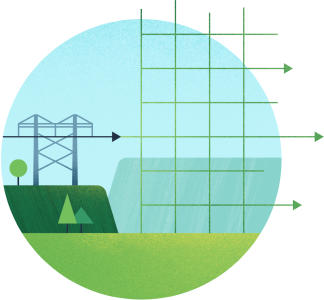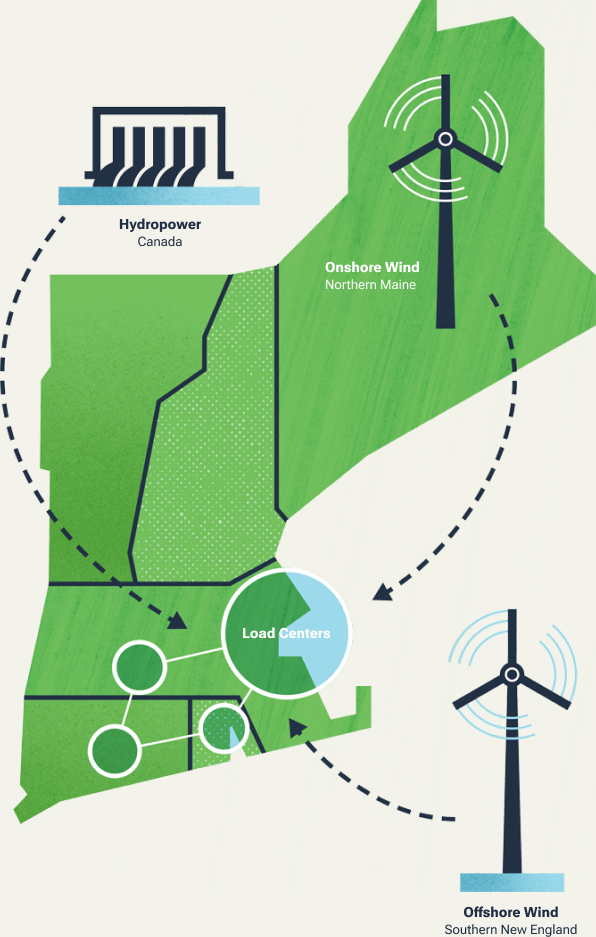Pillar Four
Robust Transmission

Pillar four status:
Yellow
Significant investment in new and existing infrastructure
will be critical to enabling the clean energy transition.

Creating Room to Grow
The backbone of the region’s power grid is its high-voltage transmission system—9,000 miles of wires, as well as substations and other equipment, that bring electricity from the places where it’s generated and stored to places where it’s distributed for consumption by homes and businesses.
Today’s transmission system is a strong one. In the past two decades, the region has made significant transmission investments to protect reliability and serve the electricity needs of New Englanders. These investments have also allowed for the retirement of many older power plants and brought about market efficiencies by reducing congestion and out-of-market operating costs. But in the next two decades and beyond, the transmission system must become significantly more robust if it is to continue meeting the region’s changing needs.
Higher demand, broader network
On the one hand, demand will grow dramatically as we become more reliant on electricity for heating and transportation. On the other hand, the sources of electricity will become greater in number and more geographically dispersed as new clean energy resources come on line. These will include remote wind and solar farms, many of them incorporating battery storage.
Proposed transmission projects aim to deliver clean energy to areas of highest demand—New England's “load centers.” Sources include wind farms in northern Maine and off the coast of southern New England, as well as hydroelectric dams in Québec.

Developers are proposing transmission upgrades that would deliver over 14,000 megawatts of clean energy from remote areas to the places in New England where it’s needed most. Even so, the ISO projects that, by 2050, more than half of the transmission system could face thermal overloads during times of peak demand. As part of the 2050 Transmission Study, the ISO has identified several potential “roadmaps” for addressing this risk and potential costs associated with each approach. While some new construction will be unavoidable, many needs can be addressed by increasing the capacity of existing transmission lines at relatively low cost.
The study found that overall costs could be mitigated significantly by shifting electricity demand away from peak hours, through measures such as demand response and flexible charging of electric vehicles and energy storage devices. Cumulative costs to upgrade the transmission system could reach $17 billion to reliably serve a 51 gigawatt peak in 2050, or $26 billion to support a 57 gigawatt peak. To reach those levels, the region’s annual investment in transmission reliability projects over the next 26 years would need to roughly keep pace with or exceed the average spent each year over the past two decades.
An estimated $620 million to $1 billion in transmission reliability investment will be needed each year through 2050 to support the clean energy transition.
As a next step in the study, stakeholder discussions are underway around creating a process to allow the ISO and the New England States Committee on Electricity (NESCOE) to choose which transmission system concerns to address, and to solicit project proposals and advance them toward construction.
Cooperation crucial
Successfully meeting the transmission challenges ahead will take coordination between the New England states, developers, and the ISO. In the last year, one major transmission line designed to import Canadian hydropower overcame legal challenges and resumed construction. But future projects may face obstacles in the form of siting and permitting restrictions, local opposition and lawsuits, and financing difficulties. It will be crucial for the states and industry to determine how to share the costs of these infrastructure investments, as well as how to work through siting and permitting delays. The ISO stands ready to provide technical analysis to help the states pursue federal funding opportunities.
Cooperation is also needed around other transmission issues. Increasing the transparency, predictability, and cost discipline of asset condition projects is a top priority in the region. The ISO lacks jurisdiction over these projects, which are initiated by transmission companies to repair or replace older equipment. NESCOE has proposed process enhancements for asset condition projects, and the ISO continues to coordinate with the states, transmission owners, and other stakeholders on improvements. Following work in this area, collaboration will be needed to develop a process to “right-size” transmission infrastructure in anticipation of future load growth.
